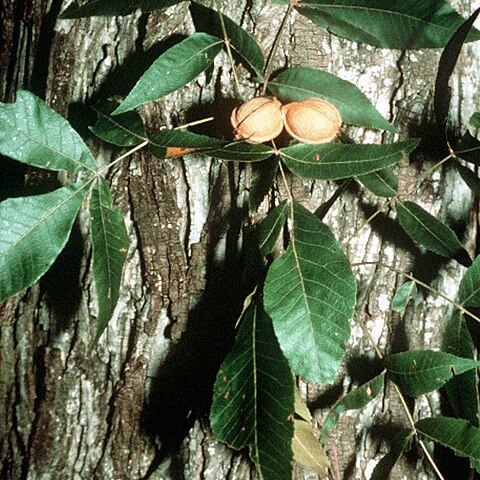Trees , to 35 m. Bark gray to brownish, fissured or exfoliating, separating freely into long strips or broad plates. Twigs brown to bronze, slender, without hairs, densely scaly. Terminal buds bronze, ovoid, 4-6 mm, essentially without hairs, densely scaly; bud scales valvate; axillary buds protected by bracteoles fused into hood. Leaves 3-6 dm; petiole 3-10 cm, densely scaly. Leaflets (5-)7-9, lateral petiolules 0-2 mm, terminal petiolules 2-3 mm; blades ovate or obovate to elliptic, not falcate, 3-17 × 1-8 cm, margins finely to coarsely serrate, without tufts of hairs, apex acuminate; surfaces abaxially with unicellular and 2-4-rayed fasciculate hairs along midrib in spring, densely scaly with coating of large peltate scales and small irregular, round, and 4-lobed peltate scales, imparting bronze color, adaxially pubescent along midrib and major veins in spring, with scattered peltate scales. Staminate catkins pedunculate, to 6 cm, stalks and bracts scaly; anthers hirsute. Fruits light tan to bronze, obovoid to ellipsoid, not compressed, 2-3 × 1.5-2 cm; husks rough, 2 mm thick, dehiscing to base, sutures winged; nuts reddish brown mottled with tan patches, ellipsoid, not compressed, not angled, smooth; shells thick. Seeds sweet. 2 n = 32.
More
A tree. It grows 21 m high and spreads 8 m wide. The bark is dark brown. The new shoots have glossy yellow scales. The leaves are green. They have broadly oval leaflets. The end leaflet is larger. The leaflets are white underneath. The flowers are very small and greenish. The male flowers have 6-7 stamen and the flowers are in slender drooping catkins. There are 3 hanging from one stalk. There are 2-10 female flowers at the tip of the same twig. The fruit is an egg shaped nut. It is 3-4 cm long. It is rust coloured. The shell is hard and grooved. The seed is edible.

